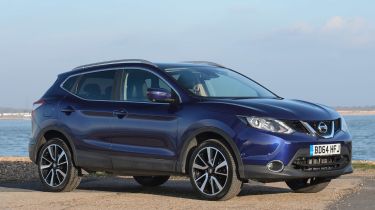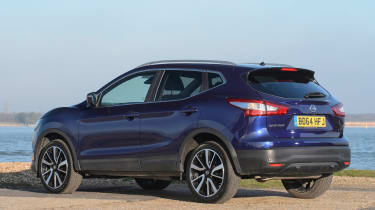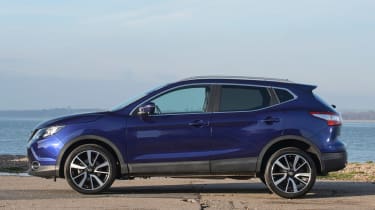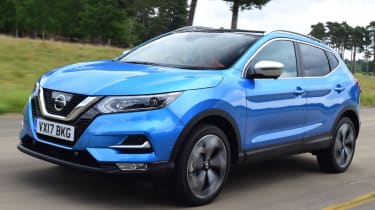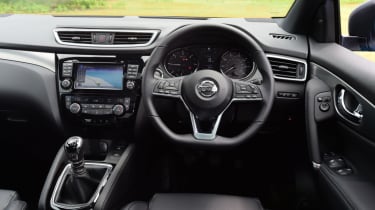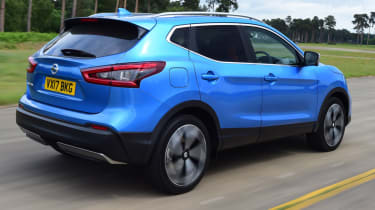Used Nissan Qashqai (Mk2, 2014-2020) review
The Nissan Qashqai Mk2 is a decent enough family SUV, but there are even better alternatives on the used market
Verdict
Nissan has sold more than 2.3 million Qashqais and it’s easy to see why. It’s good to drive, available with decent engines and as long as you avoid entry-level models, equipment levels are generous. However, while Nissan is usually synonymous with reliability, the second-generation Qashqai hasn’t proved to be very well built, illustrated by some poor Driver Power satisfaction survey results and a long recall list. Still, for most, the Qashqai is easy to love and worth a look – just buy with care.
Which one should I buy?
- Best Nissan Qashqai for low mileage: Qashqai 1.3 DIG-T Visia 2WD manual
- Best Nissan Qashqai for low costs: Qashqai 1.5 dCi Visia 2WD manual
- Best Nissan Qashqai for towing: Qashqai 1.7 dCi N-Connecta 4WD manual
The original Nissan Qashqai arrived in 2007 and was on sale for six years before being replaced by this second-generation model. The original model was a bold move on Nissan’s part, because not only was it the first-ever crossover, there were plenty of people who wondered if replacing a conventional family car with SUV styling was a wise idea.
But it proved to be the right move at the right time; almost 100,000 Qashqais were sold across Europe in the model’s first year, and the car notched up one award after another. We’ve given the second-generation car its fair share, including Best Crossover in 2014, then again in 2015.
The Mk2 Qashqai reached UK showrooms in January 2014. At first there were 1.5 or 1.6 dCi diesels along with a 1.2 DIG-T petrol. Trim levels were Visia, Acenta, Acenta Premium and Tekna, but in October 2014 n-tec trim replaced Acenta Premium.
Used - available now

2017 Nissan
Qashqai
34,380 milesManualPetrol1.2L
Cash £10,697
2016 Nissan
Qashqai
31,313 milesManualPetrol1.2L
Cash £16,549
2016 Nissan
Qashqai
39,745 milesManualPetrol1.2L
Cash £17,549
2016 Nissan
Qashqai
17,622 milesManualPetrol1.2L
Cash £18,549The 1.6 dCi was available with an optional automatic gearbox and four-wheel-drive (although you couldn’t get both at the same time), and from October 2014 the 1.2 DIG-T came with a CVT auto ’box. Sitting below Tekna, the high-spec SV1 special edition arrived in September 2014 with keyless go, privacy glass and Safety Shield (Nissan’s hi-tech driver assistance aids). These were also fitted to the Black Edition which went on sale in July 2016 and also featured 19-inch wheels, LED headlights and Park Assist.
The Qashqai range was facelifted in 2017, with minor exterior styling tweaks, a revised steering wheel and updated infotainment. It was refreshed again in 2019, with new engines and a trim-level reshuffle; a new range of petrol and diesel units with more power and improved economy across the board was introduced, including a pair of 1.3-litre DIG-T petrol engines arrived alongside with 1.5- and 1.7-litre dCi diesels. The new trim levels were Visia, Acenta Premium, N-Connecta, N-Tec, Tekna and Tekna+.
What are the alternatives?
As one of the most popular segments across Europe for years, there’s no shortage of great compact SUVs and crossovers to choose from on the used market.
For value, the Kia Sportage is hard to beat; a seven-year warranty means peace of mind comes as standard, too. The Renault Kadjar is closely related to the Qashqai, but finished third in the latest Driver Power survey, and is sold at more competitive prices. The Skoda Yeti has always done incredibly well in Driver Power, too.
Other rivals include the Toyota RAV4 and Honda CR-V, which are reliable and well built. For driving enjoyment, availability and value, the Ford Kuga is hard to beat, but also check out the Mazda CX-5 for its style, value and sharp dynamics.
Nissan Qashqai vs SEAT Ateca ve Peugeot 3008
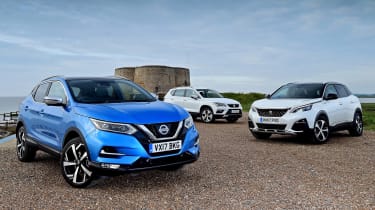
In 2017, we put the facelifted Qashqai up against more modern competition in the form of the SEAT Ateca and Peugeot 3008. We found the Peugeot to be more comfortable and the SEAT better to drive, and even post-facelift, we criticised its infotainment and practicality deficit. Read the full test...
Nissan Qashqai vs Jeep Renegade vs Mazda CX-5
The Jeep Renegade arrived in 2015 to a crowded market that included the pre-facelift Qashqai. The Nissan finished second in this test, losing out to the Mazda CX-5’s combination of space, performance and low running costs. Read the full test...
Nissan Qashqai vs Renault Kadjar
It’s no secret that the second-generation Nissan Qashqai and the Renault Kadjar are essentially the same car beneath their different styling. Both cars were engineered to have separate characters, and in 2015 it was the Renault that came out on top thanks to a larger boot and more upmarket feel. Read the full test...
How much will a used Nissan Qashqai cost?
The Nissan Qashqai has become something of a household name and its values are slightly buoyed by its reputation. A used example is still great value, however, with post-2017 cars projected to have lost around 42–49 per cent of their value after 36,000 miles and 36 months according to our experts.
Prices
With that figure in mind, it’s easy to see the appeal of a relatively low-mileage car that’s lost so much of its original value. An entry-level car that cost just over £25,000 three years ago is worth less than £12,000 today; while a grand more will get you a top-of-the-line example that would have cost its original owner closer to £30,000.
Of course, the used car market isn’t always as clear-cut as depreciation figures suggest; dealers will add on some cash to make the sale worth their while, especially on higher-spec examples. It makes sense to prioritise low mileage and evidence of regular servicing, especially when looking at older, pre-facelift Qashqai models.
You can check out the latest used prices for the Nissan Qashqai on our Find a Car service or value a specific model using our free car valuation tool.
Fuel economy and emissions
Fuel economy and CO2 emissions are respectable across the Qashqai range, especially if you choose from the line-up of new, more efficient engines that appeared in 2019.
The most efficient engine is the 1.5-litre dCi diesel in seven-speed DCT guise; combined economy of 53.3mpg is strong, while CO2 emissions of 138g/km is competitive for a car of this type. Opting for the manual model delivers very little difference in these figures, although there is a slight drop in overall efficiency. Bear in mind that, in each case, economy is better on models with smaller wheels.
The more powerful 1.7 dCi diesel option is most efficient in its two-wheel-drive configuration – the claimed 51.4mpg and 145g/km of CO2 are respectable. The 1.6 and 1.7 diesels are the only ones offered with four-wheel drive; the manual 1.7 dCi returns up to 47.9mpg on average and emits 145g/km of CO2, while the 1.7 dCi Xtronic CVT auto is rated at 42.8mpg and 173g/km.
Petrol models are a great choice for those covering fewer miles. The least powerful version of the 1.3-litre DIG-T engine is available exclusively with a manual gearbox and returns up to 41.5mpg on average, with CO2 emissions of 153g/km. The more powerful DIG-T 160 has the same emissions and economy figures but when fitted with the seven-speed auto emissions increase by 3g/km and economy is 40.9mpg.
Running costs
All Nissans come with a three-year/60,000 mile warranty, which is about average for this class. If you want more cover, it’s worth remembering that the Hyundai ix35/Tucson came with a five-year warranty when new, which may still be valid; similarly, the Kia Sportage came with a seven-year warranty.
Nissan offers fixed-price servicing for the Qashqai, starting at £229. The Qashqai service intervals are every 12,500 miles for petrol models and every 18,000 miles for diesels.
Insurance for the Qashqai ranges from group 17 for the entry-level 1.3-litre petrol and 1.5-litre diesel in Visia trim, up to group 20 for the 158bhp 1.6-litre DIG-T turbo petrol.
It’s worth bearing in mind that models fitted with the Smart Vision Pack are rated a couple of insurance groups lower. This is because the pack includes features that reduce the chance of a low-speed collision. The Smart Vision Pack was fitted as standard to all but Visia models; it was an option on the entry-level car.
What do owners think?
The Mk2 Nissan Qashqai had a habit of finishing in a low- to mid-table position in our Driver Power owner satisfaction surveys. It’s worth remembering, though, that this position isn’t wholly based on reliability – the Qashqai scored fairly averagely in this area.
Reliability
The Qashqai has won plenty of awards but owners didn’t rate it so highly when it was new; it came 131st in our Driver Power 2016 satisfaction survey but 48th in 2015. Seat comfort and practicality were the highlights (it finished a respective 50th and 52nd in this area), along with ride quality (59th). But 150th place for reliability and build quality is worrying.
The Qashqai’s performance improved in our 2018 Driver Power survey, coming 22nd out of 75 cars. With good ratings for the exterior style and build quality, together with decent scores for infotainment, practicality and running costs, Qashqai owners seemed to be happy.
However, the Nissan slipped to 49th place out of 100 cars in 2019 – owners praised fuel economy, interior space, and child-friendliness, but 23.4 per cent of owners reported an issue with their cars.
The apparent slide in customer satisfaction was more noticeable in our 2020 survey, when the Qashqai finished 56th out of 75 cars listed. This could well be down to the raft of new competitors on the market, rather than any wholesale issues with the Qashqai itself. In fact, Nissan placed a strong 11th out of 30 manufacturers in the best brands poll.
How practical is it?
When the Qashqai first arrived in 2014, it was one of the more practical crossovers in its class. Since then, a glut of newer rivals has usurped the Sunderland-built car for outright space, which means the Qashqai is merely average in this respect when compared with more modern rivals. Still, visibility is good and the adjustable boot floor is versatile.
The seven-seat Nissan Qashqai +2 was only available with the first-generation model – customer feedback suggested it wasn't a popular version. So if you need seven seats, you’ll have to opt for the larger Nissan X-Trail instead.
Dimensions, cabin and boot space
The Nissan Qashqai is 4,394mm long and 2,070mm wide including its door mirrors. That makes it slightly smaller than the Kia Sportage and similar to the SEAT Ateca. It’s a touch lower than both cars, too.
Compared to a typical family hatchback such as the Ford Focus, the Qashqai doesn't offer much more outright room. The key difference is the extra height that’s such a central part of the crossover’s appeal. Where the Focus stands 1,469mm tall, the Qashqai towers 1,595mm off the Tarmac – this makes it easier to access and gives you an elevated driving position.
Overall, there’s still decent legroom in the rear and the transmission tunnel doesn’t intrude on the middle-seat passenger’s foot space. Three adults could manage short journeys in relative comfort back there.
Equipment, technology and safety
The Qashqai has always been well equipped for its price point, but it’s worth hunting for a post-2017 model. The updated range of trim levels from this point on brought a good amount of standard equipment plus some useful upgrades.
Standard kit on Visia cars includes Bluetooth, a DAB radio and air-conditioning, while Acenta Premium adds auto lights and wipers, climate control, ambient interior lighting and 17-inch wheels, along with TomTom sat-nav, Android Auto and Apple CarPlay.
The Qashqai is particularly well equipped as you move further up the range. N-Connecta adds 18-inch alloys, rear privacy glass and a range of driver assistance and safety systems, including blind-spot warning, intelligent cruise control and a 360-degree parking camera.
Moving up the range to the N-Tec trim level brings black exterior trim, a panoramic glass roof and adaptive LED headlights. The Tekna models feature 19-inch alloys, part-leather upholstery and a premium eight-speaker Bose stereo with a subwoofer. Tekna+ models bring a sportier bodykit, Nappa leather interior trim and extended electric adjustment of the front seats, along with unique 19-inch alloys as a no-cost option.
Safety
Safety experts at Euro NCAP awarded the Qashqai a full five stars in 2014, with the car scoring well in the adult and child occupant categories.
Nissan fitted the Qashqai with its Safety Shield technology, which comprises clever features such as front collision avoidance (autonomous braking), lane departure warning, drowsiness detection, blind spot warning and traffic sign recognition. There are even cameras to help you park and detect moving objects behind the car when you’re reversing – the Qashqai can even park itself, too.
For 2017, Nissan added rear-cross traffic alert, which warns you if there's traffic behind you when reversing out of a space. The autonomous braking system was also upgraded with the addition of pedestrian detection.
What’s it like to drive?
The original Nissan Qashqai was surprisingly fun to drive, but the second-generation model took a more mature approach. Levels of noise and vibration in the cabin were vastly improved, with much less intrusion from the road and engine noise making its way inside – particularly on the motorway.
Engines
The Nissan Qashqai was originally introduced with a pair of diesel engines: the 1.5 and 1.6 dCi, along with a single 1.2-litre petrol engine badged DIG-T. The petrol was only offered with a manual gearbox until the end of 2014 when a CVT option was added. The diesel was available with manual or automatic gearboxes, plus four-wheel drive.
Post-facelift cars got a pair of 1.3-litre DIG-T four-cylinder engines; the DIG-T 140 has 138bhp and the DIG-T 160 has 158bhp. The former is mated to a six-speed manual gearbox and manages 0-62mph in 10.5 seconds; the more powerful model drops this to 8.9 seconds, or 9.9 when fitted with the optional seven-speed DCT.
Two diesels make up the rest of the range; the 1.5-litre dCi 115 has 113bhp and the 1.7-litre dCi 150 puts out 148bhp. Acceleration is not terribly impressive: the 1.5-litre gets to 62mph in 12.3 seconds in manual guise, or 13 seconds with the automatic, while the 1.7-litre model does 0-62mph in 9.5 seconds with a manual gearbox regardless of how many wheels are being driven. The four-wheel-drive Xtronic CVT model is slower, at 11.2 seconds to 62mph.
On the road
The Qashqai feels reasonably composed on a twisty B-road; the electrically assisted steering is direct and surprisingly weighty in feel, while traction is good. Nissan’s Active Trace Control applies the brakes on individual wheels to help you stick to your chosen cornering line, but it feels as if the car never quite settles once you’ve turned in. A SEAT Ateca is sharper in the bends, while the Peugeot 3008 and Mazda CX-5 feel more direct and agile.
For 2017, the suspension and steering were revised and retuned to improve stability and settle the ride a bit more, while the Active Ride Control system was also tweaked. The changes were subtle; noise levels were reduced further, making it respectably refined, while new Active Return Control tech made the steering feel a bit more natural.
The Qashqai also features Nissan’s Active Engine Brake function, which reduces jerkiness in the transmission when you lift off the throttle. Plus, the Body Motion Control technology constantly dabs the brakes to smooth out body movement over bumps. It works well, particularly at low speed, although it's less composed if you hit a series of small imperfections.
What should you look out for?
Nissan generally has a good reputation for build quality and reliability but, as with all cars, there’s always room for issues.The Qashqai has a few problems to look out for, some more serious than others, and most of them were dealt with via recalls, which may have already been carried out. Check through the following list before you buy and make sure any recalls have been taken care of by contacting your local Nissan dealer.
Common used Nissan Qashqai problems
Sensor faults
The parking sensors are known to fill up with water and then either bleep when they shouldn’t or fail to bleep when they should.
Trim damage
When the rear seat backs are put up, the seat belts get trapped, which can lead to the buckles damaging the seat fabric.
Air-con woes
Quite a few owners have had problems with the air-con, which can fail.
Entertainment
The DAB radio can sometimes work erratically. Storing stations in the memory can be difficult, and the radio can cut out while on the move.
Interior
The dashboard looks smart, but cabin quality is variable.
Recalls
Despite Nissan’s reputation for thorough engineering, the Qashqai Mk2 had multiple recalls during its production.
The first recall in December 2014 affected cars built between July and October of that year with a factory-fitted tow bar, which could detach.
The next recall was in July 2016 and affected cars built between April 2015 and May 2016, as well as a number of other Nissan models. The rear oxygen sensor in the exhaust on these could fail, with no warning being displayed on the dash. The ECU was reprogrammed on faulty cars.
In 2017 there was a recall concerning the rear right wheel-arch protector, which could deform and damage a brake hose. This affected cars built between September 2013 and May 2016 – some 25,000 models.
In 2018 a recall was issued regarding the Qashqai’s quoted gross combination weight on its VIN label. This affected cars built between June and October 2017 inclusive, or around 8,300 examples.
A recall in 2019 concerned the radiator fan assembly motor controller, which may have had a ceramic capacitor fitted that could fail. Models built between June and November (inclusive) of 2018 were affected, or just over 10,000 cars.
Another VIN label mistake was cause for a recall in 2019, with some displaying incorrect permissible front axle figures. Cars affected were built in a short period in August and September of that year, with just 12 cars listed.
In 2020 it was noted that models across Nissan’s range could have rear door child lock switches with ‘possible reduced retention force’. Qashqais built between September 2015 and March 2018 inclusive could be affected.
The latest recall was issued in 2021 and was another information mistake, this time on the car’s certificate of conformity. Just 10 examples built between March and September of 2020 (inclusive) were affected.
